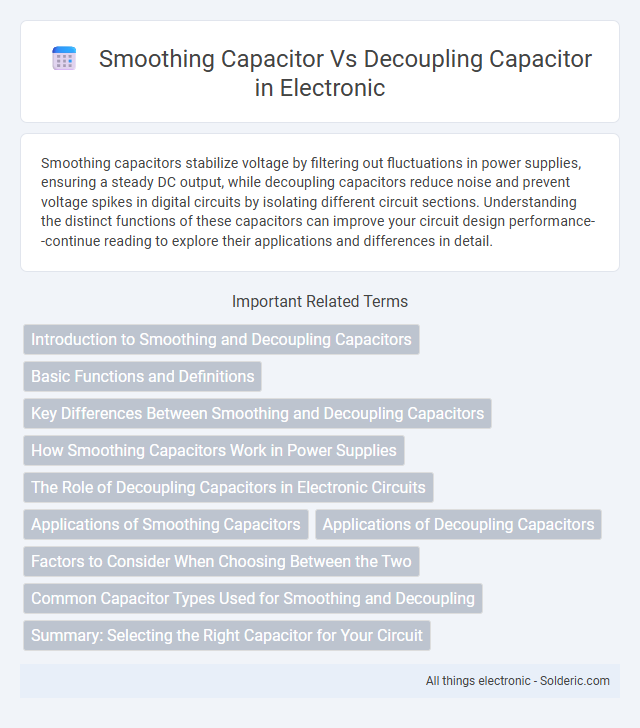Smoothing capacitors stabilize voltage by filtering out fluctuations in power supplies, ensuring a steady DC output, while decoupling capacitors reduce noise and prevent voltage spikes in digital circuits by isolating different circuit sections. Understanding the distinct functions of these capacitors can improve your circuit design performance--continue reading to explore their applications and differences in detail.
Comparison Table
| Feature | Smoothing Capacitor | Decoupling Capacitor |
|---|---|---|
| Primary Function | Reduces voltage ripple in power supplies | Filters noise and stabilizes power supply to ICs |
| Placement | After rectifier in power supply circuits | Near integrated circuit power pins |
| Capacitance Value | Usually large (uF to mF range) | Small (pF to uF range) |
| Frequency Response | Effective for low-frequency ripple smoothing | Effective at high-frequency noise filtering |
| Common Types | Electrolytic capacitors | Ceramic capacitors |
| Role in Circuit | Maintains steady DC voltage output | Prevents voltage spikes and transient disturbances |
Introduction to Smoothing and Decoupling Capacitors
Smoothing capacitors are designed to reduce voltage ripple in power supplies by storing and releasing energy, ensuring a steady DC output from a fluctuating AC input. Decoupling capacitors minimize noise and voltage spikes in electronic circuits by stabilizing the power supply near sensitive components, effectively filtering high-frequency interference. Your choice between smoothing and decoupling capacitors depends on whether you need to stabilize overall voltage levels or protect specific circuit elements from transient disturbances.
Basic Functions and Definitions
Smoothing capacitors primarily function to reduce voltage ripple in power supplies by storing and releasing energy to maintain a more constant DC voltage output. Decoupling capacitors serve to suppress voltage spikes and noise within electronic circuits by providing a local reservoir of charge, thereby stabilizing the power supply voltage seen by integrated circuits. Both capacitors are essential in achieving stable and clean power delivery but differ in placement and specific roles in circuit operation.
Key Differences Between Smoothing and Decoupling Capacitors
Smoothing capacitors primarily reduce voltage ripple in power supplies by filtering the rectified output to provide a stable DC voltage, whereas decoupling capacitors suppress high-frequency noise and transients in electronic circuits to ensure proper operation of ICs. Smoothing capacitors typically have large capacitance values to store energy and maintain voltage stability, while decoupling capacitors use smaller capacitance placed close to power pins for rapid response to voltage spikes. Understanding the key differences between these capacitors is essential for optimizing your circuit's power quality and noise immunity.
How Smoothing Capacitors Work in Power Supplies
Smoothing capacitors work in power supplies by filtering out voltage fluctuations and converting the pulsating DC output of rectifiers into a more stable and continuous DC voltage. They achieve this by charging during voltage peaks and discharging during voltage drops, thus reducing ripple voltage and improving the overall power quality. Your power supply's performance and reliability depend heavily on the effectiveness of these capacitors in maintaining a consistent voltage level.
The Role of Decoupling Capacitors in Electronic Circuits
Decoupling capacitors play a crucial role in electronic circuits by filtering out voltage spikes and noise, ensuring a stable power supply to sensitive components and enhancing overall device performance. Unlike smoothing capacitors that primarily reduce ripple in power supplies, decoupling capacitors are placed close to integrated circuits, providing instantaneous current during fast switching events and preventing electromagnetic interference. Your circuit reliability depends significantly on the proper use and placement of decoupling capacitors to maintain signal integrity and reduce transient voltage fluctuations.
Applications of Smoothing Capacitors
Smoothing capacitors are primarily used in power supply circuits to reduce the ripple voltage after rectification, providing a steady DC output for electronic devices. They are essential in applications such as battery chargers, DC power supplies, and audio amplifiers where a stable voltage is critical. Your circuit's performance improves significantly by minimizing voltage fluctuations through the effective use of smoothing capacitors in these systems.
Applications of Decoupling Capacitors
Decoupling capacitors are primarily used in electronic circuits to stabilize voltage supply by filtering out noise and transient voltage spikes, ensuring reliable operation of integrated circuits (ICs) and microcontrollers. They are strategically placed close to power pins of ICs to minimize noise coupling and maintain signal integrity, especially in high-frequency digital circuits. Their applications include power supply filtering in computer motherboards, LED drivers, and communication devices to prevent voltage fluctuations from affecting sensitive components.
Factors to Consider When Choosing Between the Two
When choosing between a smoothing capacitor and a decoupling capacitor, consider the primary function: smoothing capacitors reduce voltage ripple in power supplies, while decoupling capacitors suppress high-frequency noise in circuits. The capacitance value, voltage rating, and placement relative to other components impact performance, with smoothing capacitors typically larger and placed after rectifiers, and decoupling capacitors smaller and located near integrated circuits. Assess your circuit's specific needs for voltage stability or noise reduction to determine which capacitor best optimizes Your device's reliability and signal integrity.
Common Capacitor Types Used for Smoothing and Decoupling
Electrolytic capacitors are commonly used for smoothing purposes in power supplies due to their high capacitance values, which effectively reduce ripple voltage. Ceramic capacitors are preferred for decoupling applications because of their low equivalent series resistance (ESR) and fast response, helping stabilize voltage and filter out high-frequency noise near integrated circuits. Your choice of capacitor type depends on the specific requirements of ripple reduction or noise suppression in your electronic circuit.
Summary: Selecting the Right Capacitor for Your Circuit
Choosing the right capacitor for your circuit depends on the application: smoothing capacitors reduce voltage ripple in power supplies by storing and releasing energy, while decoupling capacitors filter high-frequency noise and stabilize voltage in digital circuits. Smoothing capacitors typically have higher capacitance values and are placed after rectifiers, whereas decoupling capacitors are smaller, often ceramic, and located close to IC power pins to maintain signal integrity. Understanding these roles ensures your circuit achieves optimal performance and reliability.
smoothing capacitor vs decoupling capacitor Infographic

 solderic.com
solderic.com